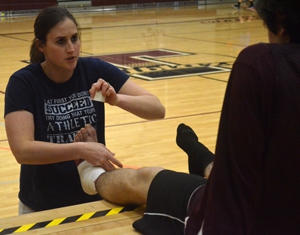
Article reposted from Torrington Telegram
Author: Erick Starkey
Emily Yorges has been working at North Platte Physical Therapy and with Goshen County athletes for seven years, but her athletic training practices are felt beyond the county lines.
Yorges got interested in athletic training in Douglas, where she went to high school. She took sports medicine classes that were taught by the full-time athletic trainer for the Bearcats and that is where she initially got the bug to work in the athletic training field.
Following high school, Yorges went to the University of Wyoming, but as a nursing major. Once in Laramie for a little while, she changed her major to athletic training, which is what her degree is in. She graduated from UW in 2010.
“That was the last class of athletic trainers that came out of there as a bachelor’s degree,” Yorges said. “June before my senior year, UW sent out an email that said the athletic training program has been dropped. If you are a junior or lower you have been dropped from your classes, but seniors can finish, so I was really lucky to finish.”
While a Cowboy, Yorges spent plenty of time with the collegiate athletics programs. She said that as a senior, working with the teams was basically a full-time job because there were only five seniors at the time that had to cover all UW sports practices and games.
After graduating from UW, Yorges moved to Torrington with her now husband. She used her old connections with the athletic trainer at Douglas to get in contact with Marnie Herring, the director of Torrington’s North Platte Physical Therapy. Yorges called Herring and the two set up the official athletic training program for the area high schools, although Herring was doing some athletic training at Southeast before Yorges got to town. The program started in 2010, with Yorges starting full-time a week after her graduation in Laramie.
“(Herring) was kind of already covering Southeast, but we just made it an official thing and proposed it to the school district,” Yorges said. “I have been doing it ever since.”
Although Yorges works with the local schools, she spends most of her daytime hours in the clinic, working with patients and athletes alike. She said she gets athletes in the clinic everyday. The clinic offers a bumps and bruises program that allows local athletes two free visits per sports season.
“I think that Goshen County is definitely at an advantage because these kids have access to this facility pretty much at all times,” Yorges said. “(Having this facility) is essential.”
On top of spending time at the clinic, the three athletic trainers are contracted with the school district to cover every home varsity event. They also go to each school’s practices twice a week to treat any issues throughout the week. For practices, Yorges said she is there to tape players if they need it and look at anyone who has an injury. During games, she has the same responsibilities, but is also there for any injuries that happen throughout the contest.
“You’re there in case somebody gets hurt,” Yorges said. “I have the coolest job because I can show up at a sporting event and I can watch and if I get to watch the whole thing from the bench, that’s a good game to me – when people don’t need me.”
Yorges is there to help care for athletes with any in-game needs. She said she has become accustomed to working out of a 50-pound bag with anything she may need during a game. Depending on the in-game injury, Yorges does several tests and checks out the injury fully.
“If you get hurt in the game, I have a mental checklist of things I’m going through – questions I’m asking you, things I’m testing, specials tests I’m doing like looking for range of motion and strength in whatever body part,” Yorges said. “I’m going through my own mental checklist of what I was trained to do.”
While going through the checklist, Yorges is making the decision of whether a player should return to the court or field.
“We have some great coaches in the county and communication is huge,” Yorges said. “Athletic trainers help take the pressure off of coaches to make return-to-play decisions. Coaches shouldn’t have to make those decisions. Their job is to coach.”